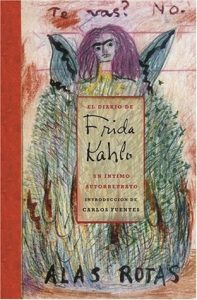While many artists are recognized posthumously, our fourth Theme Thursday features a woman whose work didn’t receive much acclaim until 30 years after her death. During her life, Frida Kahlo was often thought of as Diego Rivera’s wife. It wasn’t until feminist art historians began to sing her praises during the 1980s that she became internationally recognized for her surrealist portraits.
The Diary of Frida Kahlo: An Intimate Self-Portrait, with introductions by Carlos Fuentes and Sarah M. Lowe, recreated Kahlo’s personal diary. From the book cover: “Published here in its entirety, Frida Kahlo’s amazing illustrated journal documents the last ten years of her turbulent life. This passionate, often surprising, intimate record, kept under lock and key for some forty years in Mexico, reveals many new dimensions in the complex persona of this remarkable Mexican artist.
 Covering the years 1944-45, the 170-page journal contains Frida’s thoughts, poems, and dreams, and reflects her stormy relationship with her husband, Diego Rivera, Mexico’s famous artist. The seventy watercolor illustrations in the journal – some lively sketches, several elegant self-portraits, others complete paintings – offer insights into her creative process, and show her frequently using the journal to work out pictorial ideas for her canvases.
Covering the years 1944-45, the 170-page journal contains Frida’s thoughts, poems, and dreams, and reflects her stormy relationship with her husband, Diego Rivera, Mexico’s famous artist. The seventy watercolor illustrations in the journal – some lively sketches, several elegant self-portraits, others complete paintings – offer insights into her creative process, and show her frequently using the journal to work out pictorial ideas for her canvases.
The text entries, written in Frida’s round, full script in brightly colored inks, add an almost decorative quality, making the journal as captivating to look at as it is to read. Frida’s childhood, her political sensibilities, and her obsession with Diego are all illuminated in witty phrases and haunting images.
Although much has been written recently about this extraordinary woman, Frida Kahlo’s art and life continue to fascinate the world. This personal document, published in a complete full-color facsimile edition, will add greatly to the understanding of her unique and powerful vision and her enormous courage in the face of more than thirty-five operations to correct injuries she had sustained in an accident at the age of eighteen. The facsimile is accompanied by an introduction by the world-renowned Mexican man of letters Carlos Fuentes and a complete translation of the diary’s text. An essay on the place of the diary in Frida’s work and in art history at large, as well as commentaries on the images, is provided by Sarah M. Lowe.”

